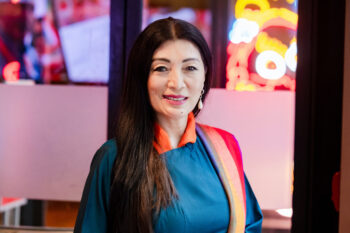
Left: Tara in Her Pure Realm, Khadiravana; Tibet; 19th century; Pigments on cloth; silk brocade; Rubin Museum of Himalayan Art; C2002.48.1
Right: Photo by Filip Wolak

Left: Tara in Her Pure Realm, Khadiravana; Tibet; 19th century; Pigments on cloth; silk brocade; Rubin Museum of Himalayan Art; C2002.48.1
Right: Photo by Filip Wolak
Reflections and insights from the voices behind the original Rubin Museum podcast
The Rubin Museum of Himalayan Art is celebrating a remarkable milestone: the 500th episode of our Mindfulness Meditation podcast. What began as a weekly gathering at the Museum’s former building has grown into a globally accessible podcast with nearly 1.5 million listens worldwide. For over a decade, the podcast has offered regular moments of calm while bringing insights from Himalayan cultural traditions to people’s contemporary lives. Listeners have described the podcast as a “go-to for morning meditation” and an experience that “always clears my head and relaxes me.” Week after week, guest teachers such as meditation trailblazers Sharon Salzberg and Tracy Cochran have explored how Himalayan art from the Rubin’s collection can open the mind and awaken compassion.
For the Rubin team who have nurtured the program since its earliest days, this milestone offers a chance to reflect on the impact of the podcast, how it has changed, and how it continues to evolve and find new ways to connect with audiences worldwide.

Photo by Filip Wolak
Tashi Chodron, Himalayan programs and communities ambassador at the Rubin, has witnessed the program’s growth from the very beginning as the host. She remembers when the popular midweek in-person sessions filled the Museum’s theater to capacity. “We used to have 150 people in the middle of the day,” she says. “The biggest challenge was not having enough seats—it was hard to turn people away.”
Jacqueline Smith, manager of curriculum development and education at the Rubin, calls managing the program “a labor of love.” She describes each week’s meditation as both a professional joy and a personal anchor. “The monthly themes, such as intention, renewal, and balance, echo my life circumstances,” she says. “It’s as if the teachers are speaking to me directly.”
Over the course of 500 episodes the world has gone through some major shifts, and the events of the day often shape the approach for each session. Jacqueline recalls an episode featuring teacher Leslie Booker, who explored the concept of “fierce compassion” through the Wrathful Shrine Doors in the Rubin’s collection. According to Jacqueline, “Her reflection on how we can embody fierce compassion by advocating for social and racial justice is powerful.”
For many, the weekly Mindfulness Meditation podcast is a steady companion through change, both in their personal lives and in the broader world. According to the feedback from participants, Mindfulness Meditation can be a lifeline—a moment of peace and hope in the middle of chaos. For Tashi, ”Things like that really inspire us to do more and continue with these programs. Not just programs, but education—making the art alive.”

Photo by Filip Wolak
Just like the Rubin has transformed over the years, so have the Mindfulness Meditation sessions. During the pandemic, Rubin educators sought new ways to connect art and meditation across geographic and social distances. Tashi also introduced a “living traditions” component to the sessions, which illuminates how centuries-old Himalayan art continues to be part of daily life today. “If it is a prayer wheel that we are talking about for that particular theme, I would get a video of that particular artwork in practice, and then share that for the living tradition,” she explains. “We had people so moved, in tears over how inspired and connected they felt to the artwork.”

Photo by Filip Wolak
The process of pairing art and meditation is at the heart of planning the weekly podcast. Each month Rubin staff and interns research works from the Rubin’s collection that align with the program’s themes. After working at the Rubin for almost 20 years, Tashi knows the collection intimately, and she and Jacqueline work with the interns to select the artwork for each session. “It’s an empowering experience for them to choose artworks that are featured on the podcast. The interns select six to seven objects from our collection per month,” Jacqueline explains. “Then each Mindfulness Meditation teacher chooses the ones that resonate with them the most.”
Both Tashi and Jaqueline resist choosing just one favorite among the 500 episodes. But episodes led by Lama Aria Drolma are among those Jacqueline would recommend the most to someone just beginning a meditation practice. “I find it so profound to listen to all of Lama Aria’s podcast episodes. She gives such relatable examples in this podcast episode about handling life’s challenges.”

Photo by Filip Wolak
As the Rubin continues to evolve, the Mindfulness Meditation podcast endures as an example of the Museum’s mission to expand awareness, enhance well-being, and cultivate compassion through Himalayan art. “The Mindfulness Meditation program enables us to seek refuge within. We delve into the teachings of compassion, interdependence, and impermanence that underlie the works of art,” Jaqueline reflects. “This process of awakening fosters serenity. As we begin to embody the attributes of loving kindness and gratitude we live life with a greater sense of intention.”
Tashi hopes the podcast’s legacy offers listeners peace and awakening. “Each of us has that Buddha nature, which is the wisdom that, according to Tibetan Buddhism, we each have that the true innate basic goodness, the loving kindness, and because of these afflictive emotions—anger, hatred, jealousy, ignorance—we are so obscured with these that it creates so much negative energy,” she explains. “So with these teachings from all these great guest teachers that we have, I hope it awakens the basic goodness, the innate basic goodness, the loving kindness that is within each of us and brings a smile, lightness, and peace.”
After 500 episodes, the Mindfulness Meditation podcast continues to invite listeners to quiet the mind, open the heart, and engage with the world more consciously. Tune in each week for new episodes on rubinmuseum.org, Apple Podcasts, Spotify, or wherever you listen to podcasts.

Tashi Chodron is the Himalayan programs and communities ambassador at the Rubin Museum of Himalayan Art.

Jacqueline D. Smith is the manager of curriculum development and education at the Rubin Museum of Himalayan Art. She began her career teaching social and emotional learning in New York City public schools and has over a decade of experience in museum education. Jacqueline is deeply committed to connecting museum audiences with art through social and emotional learning principles.
Get the latest news and stories from the Rubin, plus occasional information on how to support our work.